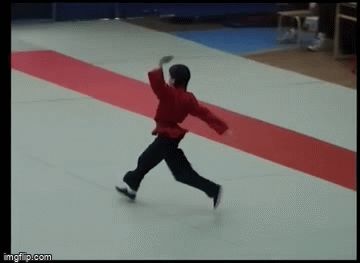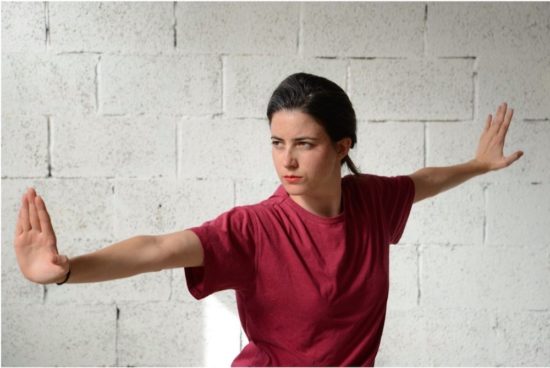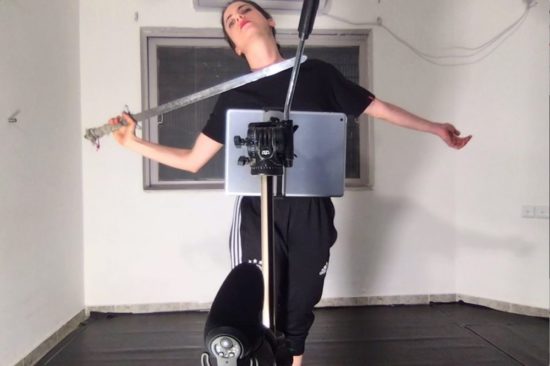Pursuing Freedom- Finding the Art in Martial Art
 gif
gif
As a young girl in Paris, Yoanna Blikman took easily to martial arts. By the time she entered high school, she had already racked up an impressive list of titles, among them Kung Fu Champion. Studying under a great female master, Blikman was taught that she could control her body and evade people who would try to hurt her. And she believed it. “You know, I was the French Kung Fu Champion eight times, but when I was in bed, at thirteen, with a boy I was in love with, it didn’t help me to stop him after I had already said I didn’t want to,” wrote Blikman in a Facebook post.
Following the aforementioned incident, Blikman lost her faith in martial arts and in herself. Unlike so many survivors of sexual assault who turn to self-defense to find empowerment, Blikman suddenly saw everything she had been taught to believe in as a lie. “In reality, violence doesn’t come at you like in Kill Bill,” she wrote.
Blikman, 31, is a petite woman with dark hair and fair skin. She is often compared to Snow White. Her small stature and beauty attract a lot of attention, often of the unwanted nature. “People have said to me that it happened ‘when I was a girl.’ It didn’t. It has happened to me my entire life,” she said recently over the phone.It took nearly two decades, a relocation to Israel, years studying dance and eventually becoming a dance artist and a shift in perspective for her to return to fully make amends with martial arts. In that time, Blikman experimented with different methods such as Capoeira and even deciphered a technique called Kung Fu Dance, which she has taught to both adults and children for the past several years. But returning to true martial arts training was not a possibility until recently.
“It started with a residency at the El Halev Organization, a program that provides education for violence prevention to women. I met them two years ago when I was teaching Kung Fu Dance, which was a combination of dance and martial arts. They suggested to me that I could learn empowering self-defense. They saw that a lot of female martial artists had experienced violence or a sexual assault and realized there was a gap between what they had learned and their real-life experience. They froze,” she said over the phone recently.
“The meeting with El Halev allowed me to find healing and to connect with martial arts again. Their method really allowed me to heal myself and to connect with women, it gave me a new purpose and vision.”
This vision found fruition in Pursuing Freedom: Dreaming Up Feminine Martial Arts, a multi-faceted project initiated by Blikman. “In the framework of my residency at El Halev, I wanted to go beyond what I had been learning in self-defense. I understood that the more I learned to set boundaries the more I was able to say yes to my own desires. From there the connection between martial art and sexuality started in my project. My will was not only to defend myself but to decolonize the female body, to free the intimate and the public space from the patriarchy in order to find freedom. That’s how I started to dream of a Sexual Martial Art. The whole period of the residency coincided for me with the falling in love with Capoeira, an African-Brazilian martial art created by slaves fighting for freedom and independence. Personally, I feel a very strong link between this fight and the fight that I feel women need to wage every day in order to survive. I believe that, as women, our history is very close to that of slavery: our body has been sold in all kinds of patriarchal contracts, we are constantly erased from the space and from the language. I believe that we need to train every day, to train our faith, to practice freedom and to discover our own fighting powers.”
One part of the project is a performative movie, entitled Foto Fight, in which Blikman reclaims her own sexuality through the reappropriation of the camera, a tool used by centuries to objectify and sexualize women. “The virtual video performance Foto Fight takes place via Zoom Theater. Mayoza, initiator and prophetess of the revolution for the liberation of cameras and the women of the world, goes forth to battle the dominating patriarchal male gaze. During the performance, Mayoza casts a retrospective look at her life through all of the cameras that photographed her as well as those she herself held as a photographer.”
The photographic retrospective is composed of documentary materials photographed throughout the artist’s life, from the childhood Kung Fun competitions, through work as a photographer’s model as a teenager, to selfie stories, and finally performances. Foto Fight is accompanied by Mayoza’s Capoeira training sessions.
“I am very angry at photographers, movie directors and artists who used women as muses, models and actresses. We are not born to wear their concepts naked as we can appear in art history, we are not born to ‘represent’ what they wish nor to bring them inspiration. We are born to be performers, to be subjects. Mayoza calls on us to steal all the cameras from the photographers and to take the power of female representation back. What I want, as a former model, is not only to wake up from the photo shooting scene, and change the direction of the frame but also to steal the cameras from their hands. I want to bring back freedom to cameras and women. I am a camera. I am Mayoza. Mayoza is a crossing point between my Capoeira nickname ‘Manhosa’ and ‘Muse’. Mayoza is a muse who has muted, a muse who succeeded to free herself from the ‘Photographic Matrix’.”
Another element of this journey are online meetings, in which Blikman and four other women teach integrated workshops followed by discussions with celebrated female martial artists such as Boxing Champion Hanna Gabriels and dancer and martial artist Kerem Shemi.
“I want to open up this discourse about martial arts,” she said. “I am broaching this question and asking dance artists and martial artists, ‘what is female martial art?’ These little pearls are coming up about what it can be in their live and how it touches their life. There is a lot of movement and dialogue. I am giving the stage to other women.”
It seems that in her path to healing, Blikman has not only found a way to mend the factions caused by her own trauma but to bring together two worlds, martial and performance art. ““In the frame of the project ‘Pursuing Freedom: Dreaming up feminine martial art’, I created a bridge between Art and Martial Art. I started to look at myself as ‘a martial artist’ and to look at this idiom exactly as it sounds. But what does it mean to be ‘a martial artist’? Art and Martial Art are so different. In art, there is complete freedom and the endless possibility of creating a new reality. In Martial Art, there are very clear rules, a heavy hierarchy and codes of respects to masters. The martial arts are very conservative and built like patriarchal pyramids. During the artistic process, I was unable to dissociate between my daily Capoeira training and the process of my performance. It was as if i was pursuing this freedom inside of the learning of Capoeira. That’s how I made the decision to allow the Capoeira to enter in my art and eventually to let my art enter into Capoeira.”

